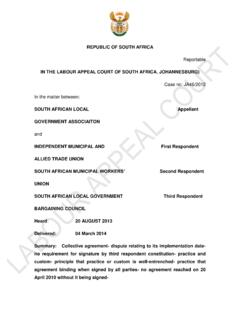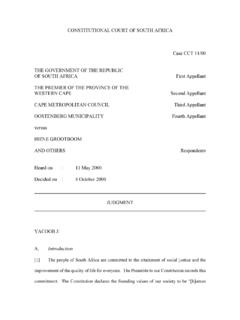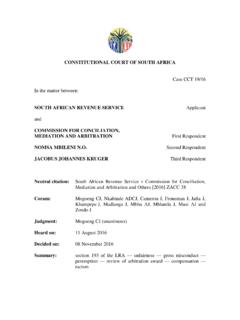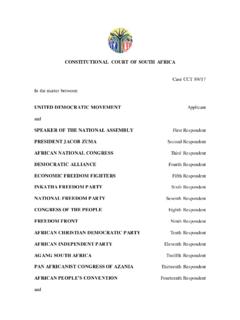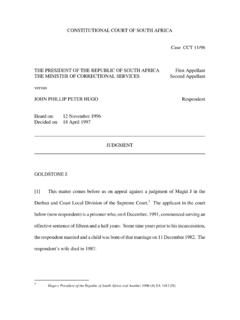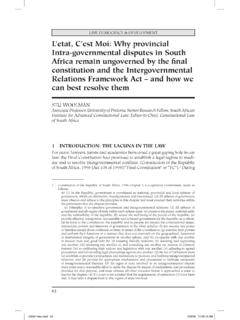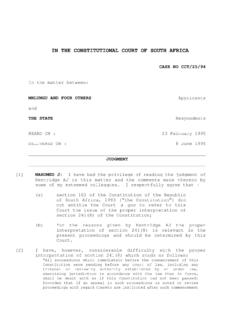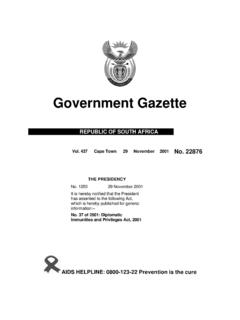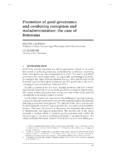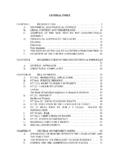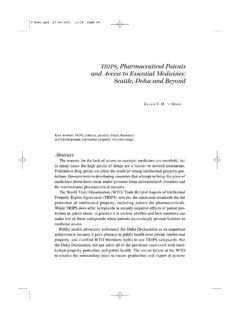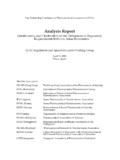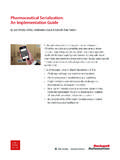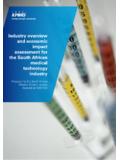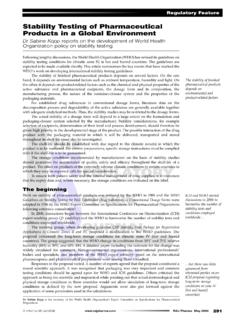Transcription of Pharmaceutical Manufacturers Association of …
1 CONSTITUTIONAL COURT of south AFRICA Case CCT 31/99 THE Pharmaceutical Manufacturers first appellant Association of south AFRICA ( Association INCORPORATED IN TERMS OF SECTION 21) THE CROP PROTECTION AND ANIMAL HEALTH Second appellant Association ( Association INCORPORATED IN TERMS OF SECTION 21) IN RE: THE EX PARTE APPLICATION OF: THE PRESIDENT OF THE REPUBLIC OF first Applicant south AFRICA THE MINISTER OF HEALTH Second Applicant THE REGISTRAR OF MEDICINES Third Applicant THE CHAIRPERSON, MEDICINES CONTROL COUNCIL Fourth Applicant THE MINISTER OF AGRICULTURE Fifth Applicant THE REGISTRAR OF FERTILIZERS, FARM FEEDS, Sixth Applicant AGRICULTURAL REMEDIES AND STOCK REMEDIES THE Pharmaceutical Manufacturers Seventh Applicant Association of south AFRICA ( Association INCORPORATED IN TERMS OF SECTION 21) THE CROP PROTECTION AND ANIMAL HEALTH Eighth Applicant Association ( Association INCORPORATED IN TERMS OF SECTION 21) Heard on : 11 November 1999 Decided on : 25 February 2000 2 JUDGMENT CHASKALSON P: Introduction [1] This case raises the question whether a court has the power to review and set aside a decision by the President of this country to bring an Act of Parliament into force.
2 It began as an application to the Transvaal High Court by the President of the Republic of south Africa, the Minister of Health, the Minister of Agriculture, certain functionaries in the Departments of Health and Agriculture, the Pharmaceutical Manufacturers Association of south Africa and the Crop Protection and Animal Health Association for the setting aside of Proclamation R49 of 19991 and Government Notice R567 of Proclamation R49 was issued by the President and purported to bring into operation the south African Medicines and Medical Devices Regulatory Authority Act, 132 of 1998 (the Act).3 Government Notice R567 was issued by the Minister of Health and purported to provide schedules to the Act in terms of section 31 read with section 54 of the Act. 1 Government Gazette 20024, Proc R49, 30 April 1999. 2 Government Gazette 20025, GN R567, 7 May 1999. 3 This was done in terms of s 55 of the Act, which provides that the Act shall come Ainto operation on a date determined by the President by proclamation in the Gazette.
3 @ [2] The circumstances in which the application was brought were as follows. Before the passing of the Act, the registration and control of medicine for human and animal use were governed by the Medicines and Related Substances Control Act, 101 of 1965 (the 1965 Act). The registration and control of agricultural substances and stock remedies were governed by the Fertilizers, Farm Feeds, Agricultural Remedies and Stock Remedies Act, 36 of 1947 (the Stock Remedies Act). The Act repealed all but a few provisions of the 1965 Act,4 and made material amendments to the Stock Remedies 4 This is in terms of s 50(1)(a) read with schedule 1 of the Act. The saved provisions of the 1965 Act are ss 1, 15B, 18, 22B, 24, 34A and 40. 5 This is in terms of s 50(1)(b) read with schedule 2 of the Act. 3 CHASKALSON P [3] The Act provides that the manufacture, sale and possession of medicines for human and animal use be controlled through a system of scheduling substances and regulating the manufacture, the sale and possession of substances in the various schedules.
4 The scheduling of medicines for human and animal use and the making of other regulations is an essential component of the regulatory system established by the Act. Schedules 1 to 9 identify regulated substances. Transitional provisions retain regulations made and schedules determined in terms of the 1965 Act and the Stock Remedies Act, but schedules 1 to 9 of the 1965 Act are specifically The Act makes provision for the determining of new schedules and the making of regulations by the It establishes the south African Medicines and Medical Devices Regulatory Authority (the Authority)8 which is to be governed by a board appointed by the Minister in accordance with the provisions of the 6 S 53 of the Act provides: A(1) Subject to this Act, all Regulations made in terms of the Medicines [and Related Substances Control] Act and any Schedules of substances which had been determined in terms of the Medicines Act remain, subject to any repeal or amendment by a competent authority, in force.
5 (2) Subject to this Act, all Regulations made in terms of the Stock Remedies Act and any Schedules determined in terms of the Stock Remedies Act in respect of stock remedies remain, subject to any repeal or amendment by a competent authority, in force. (3) Despite subsection (1), but subject to subsection (4), Schedules 1 up to and including Schedule 9 of the Medicines Act, are hereby repealed. (4) Any reference in any law or document to any medicine or substance referred to in any Schedule to the Medicines Act prior to the date of commencement of this Act, must be construed from that date as a reference to the corresponding medicine or other substance prescribed by the Minister under section 31.@ 7 In terms of s 48(2) of the Act the Minister must, not less than three months before making regulations, publish them in the Gazette for comment. 8 S 2. 4 CHASKALSON P Pending the appointment of the board, the Medicines Control Council established under the 1965 Act may perform the board=s [4] The Act was promulgated on 18 December 1998 and provides that it Acomes into operation on a date [to be] determined by the Proclamation R49, purporting to bring the Act into force, was published in the Gazette on 30 April 1999.
6 If the Proclamation is valid, the repeal of the 1965 Act and schedules 1 to 9 of that Act was effective from that date. [5] In the founding affidavit filed on behalf of the President and the other applicants in the High Court on 21 May 1999 by the acting Director-General of Health, Dr Pretorius, it was said: AThe scheduling status of Medicines is a fundamental aspect of both the 1965 Act and Act 132 of 1998 and the regulations published in terms of these two Act[s], and must 9 S 6 of the Act provides that the Minister must appoint the board within six months of the commencement of the Act. 10 S 50(4). 11 Above n 3. 5 CHASKALSON P appear on all sales packs.
7 It determines the manner in which the product may be marketed and sold.@ According to the affidavit, the regulatory base necessary for the operation of the Act was not in place when Proclamation R49 was published because schedules had not been made to replace the repealed schedules of the 1965 Act, and other essential regulations contemplated by the Act had not been made. [6] On 7 May 1999 the Minister issued Government Notice R567 which reads as follows: AThe Minister of Health has, in terms of section 31 read together with section 54 of the south African Medicines and Medical Devices Regulatory Authority Act, 1998 (Act No. 132 of 1998) on the recommendation of the south African Medicines and Medical Devices Regulatory Authority made the schedules in the Schedule@12 It is alleged in the founding affidavit that regulations necessary to give effect to other provisions of the Act were not made. It is also alleged that the Government Notice purporting to publish the schedules was invalid.
8 [7] According to Dr Pretorius the effect of the absence of schedules and regulations would be that A.. the entire regulatory structure relating to medicines .. and the control of such medicines, has been rendered unworkable by the promulgation of Act 132 of 1998 in this manner.@ 12 Above n 2. 6 CHASKALSON P This, he said, had not been appreciated by the Department of Health when it requested the President to bring the Act into operation. According to Dr Pretorius the request would not have been made, and the Act would not have been brought into force, but for this error. [8] Concerned to avoid the consequences of bringing the Act into force prematurely, the applicants applied to the High Court as a matter of urgency for an order declaring that the Proclamation and the Government Notice were invalid.
9 The Proceedings in the High Court [9] The application was dismissed by Fabricius AJ who held that the President had acted within his powers and in good faith. The fact that he had done so on the basis of incorrect advice, and that as a result the Act had been brought into force prematurely, was held not to be sufficient cause for reviewing the President's decision. [10] The seventh and eighth applicants sought leave from Fabricius AJ to appeal against his decision. That, too, was dismissed. They then applied for, and were granted, leave by the Supreme Court of Appeal to appeal to the Full Bench of the Transvaal High Court (the Full Bench). [11] The first six applicants did not participate in the appeal which was pursued only by the seventh and eighth applicants. The Full Bench, Ngoepe JP and Swart and Nugent JJ, reversed the decision of Fabricius AJ, and held that Proclamation R49 was null and void and of no force or 7 CHASKALSON P [12] In its judgment the Full Bench referred to the nature of the power exercised by the President in bringing an Act into operation, saying: AOften, as in the present case, administrative preparations are required to be made as a prerequisite to bringing the legislation into effect and it is best left to the executive branch of government to determine when the appropriate time has arrived.
10 In the constitutional structure of this country it is the President, as the head of the executive branch of government, who is the appropriate person to whom to delegate that power. However, the power that he exercises in that regard is one that is delegated to him by Parliament and not one that is conferred upon him by the Constitution. In casu, such delegation was done through s 55 of Act 132 of 1998. 13 The judgment is reported as Pharmaceutical Manufacturers Association of SA and Another: In re Ex parte President of the Republic of south Africa and Others 1999 (4) SA 788 (T). 8 CHASKALSON P It is well established that delegated powers must be exercised within the limits of the authority that was conferred.
